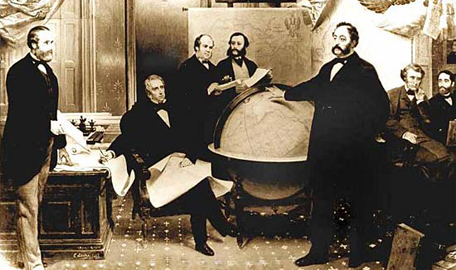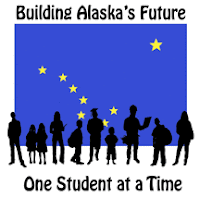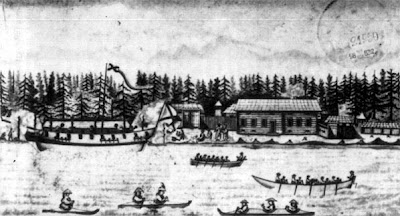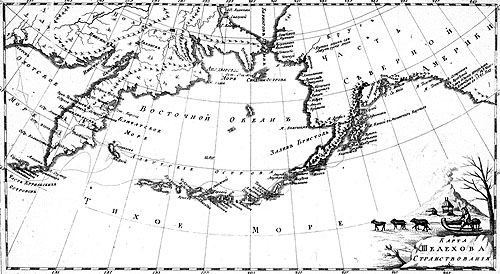Essential: How have the settlement patterns of Alaska been a reflection of the natural landscape, distance, resources, and the economy?
 |
| Kodiak Island http://en.wikipedia.org/wiki/File:Map_of_Alaska_ highlighting_Kodiak_Island_Borough.svg |
Russians made Kodiak Island there first settlement. Kodiak Island became the first permanent fur trading post in Alaska. The Alaska History & Cultural Studies website states this location was ideal because “traders at such a post could trade for furs all year and would not have to spend much of each year at sea going to and from Alaska.” Eventually Russians built trading posts in Sitka, Wrangell, Kenai, Unalaska, and so on. In 1867, the United States bought Alaska from the Russians and sent 30 ships of Americans wanting to engage in trade and commerce and exploit Alaska's natural resources. The majority of these people went to the Russian center at Sitka and various other trading posts to begin their lives in Alaska (Population and Settlements).
 |
| Juneauhttp://content.lib.washington.edu/cdm4/item_viewer.php? CISOROOT=/alaskawcanada&CISOPTR=1054 |
In the late 1800‘s mining camps had became to spring up in Alaska. For example, Juneau was founded in 1880 as a mining camp. Between 1890 and 1900, Alaska’s population exploded. News of gold in the Klondike lured around 30,000 people to Alaska. Most of the people had planned to strike it rich and leave, but some people stayed. Places like Skagway, Valdez, Chisana, and Fairbanks were founded as supply camps during the gold rush. Some of these supply camps survived after the gold rush, others were forgotten (Population and Settlements).
 |
| http://www.flickr.com/photos/dickinsonlibrary/3043377897/ |
In order to efficiently transport people and goods, the U.S. Army built Alaska’s first significant road from Valdez to Fort Egbert. Several railroads were also constructed in the early 1900s. The U.S. Government built the Alaska Railroad and encouraged people to form communities along its route. Stations along these routes did grow into small towns (Population and Settlements).
Settlement patterns of Alaska have been a reflection of the natural landscape, distance, resources, and the economy. People have generally lived near lines of transportation and trade. As technology improved the ability to transport people and goods, people moved from the oceans and rivers to the interior of Alaska. Settlements were built around roads, railroads, and airfields which always led to a resource that could be exploited (Population and Settlements).
Examine: In what ways did formal education change the culture of Alaska Natives?
 |
| http://www.iser.uaa.alaska.edu/Publications/boardingschoolfinal.pdf |
Formal education was started in Alaskan communities with the intention of wiping out Native culture. From the early 1900s to the 1970s, Alaska Natives were taken from their rural communities and sent to boarding schools. These schools were run by the Bureau of Indian Affairs (BIA), churches, or the state government. According to Paul Ongtooguk, “The agenda (of these schools) was to ‘civilize the Natives’ and to make them more like the white settlers.” Many students lost their language, culture, and identity.
In schools Native students were introduced to the American way of life and required to only speak English. In a study conducted in 2004 and 2005, an interviewee talked about his experience at the Wrangell Institute. He said, “Many children were beaten if they spoke their indigenous languages at any time. Every night, well not every night, but whenever they caught somebody, they'd bring the whole dorm down there, and they'd have the two biggest boys in the dorm, and they would give them razor straps, you know the kind you sharpen razors with, and if a Native boy, now that's all that was in Wrangell Institute at the time, if they spoke their own language, they got swatted 10 times by two of the biggest boys in school” (Hirshberg & Sharp). He finishes his account of the beatings by stating that he no longer can speak his “own language”.
 |
| BIA School Children http://jukebox.uaf.edu/site/railroads/content/children-classroom-bia-school |
Boarding schools were feeding grounds for bullies. Many interviewees explained the abuse and cruelty that went on at their schools. The Wrangell Institute was described as a violent place. Not only were students beat for speaking their Native language, they were also sexually abused. Students abused one another and adults abused the students. Rather than talk about “graduating” from Wrangell, respondents talked about “surviving” the institute (Hirshberg & Sharp).
Native students were treated differently than non-Native students. Interviewees recall that non-Native students were expected to achieve academically and pursue a college education, while Native students faced low expectations and were directed into vocational courses. In many cases Native students did not receive counseling or support for pursuing college. In other cases Natives were told by their counselors not to apply for college because they were expected to fail (Hirshberg & Sharp).
 |
| Inuits in Nome dancing and Singing http://www.everyculture.com/multi/Ha-La/Inuit.html#b |
After students completed school, they returned home to their families. Families they hadn’t seen or talked to for years. One woman talked of forgetting what her parents looked like: “Eventually, I didn’t know who my parents were.” Integrating back into their communities was a difficult task for many Natives. Several conflicts surrounding fundamental levels of community, family, and identity occurred as these students tried to find their place in the community. Sometimes Elders would be angry at them for forgetting their culture and tradition. Many interviewees described their sadness at not learning subsistence practices and traditions from their parents and grandparents and, therefore, being unable to pass these cultural traditions onto their own children (Hirshberg & Sharp).
Despite these horrifying findings, some positive memories were made at boarding schools. In fact, about 60 percent of the respondents were generally pleased with their boarding school experience. Some interviewees discussed an atmosphere of high expectations combined with support for meeting those expectations. They spoke of their extra curricular activities and the joy those activities brought to them. Most importantly, the opportunity to make friends from many places. Through these friends, students learned about the outside world and other cultures (Hirshberg & Sharp).
While researching I came across more information about the Boarding schools for Native Alaskans. If you’re interested check out these resources:
Extend: What are the health care services available in your community?
Wrangell Medical Center is the hospital in Wrangell owned by the city and governed by an elected board of directors. It offers emergency care, long term-care, laboratory services, radiology, and physical therapy (Wrangell Medical Center).
 |
| http://akics.org/index.aspx |
The primary provider of medical care in Wrangell is Alaska Island Community Services (AICS). AICS services include “health promotion, disease prevention, health maintenance, counseling, patient education, diagnosis and treatment of acute and chronic illnesses in a variety of health care settings”. AICS also provides all physician care for Wrangell Medical Center's acute care, long-term care, and emergency room(AICS). AICS has a clinic, dentist office, pharmacy, and behavioral health facility in Wrangell. If a person needs anything above and beyond what they can offer that person must leave the island and travel to a larger city like Ketchikan, Juneau, or Seattle.
Evaluate: Please write a brief paragraph reflecting on the content, style, usefulness and challenges of this module.
 |
| Wrangell Institute http://www.alaskool.org/native_ed/photoind.htm |
I really enjoyed the information in this module. I found the Alaska Community Database Community Information Summaries (CIS) to contain a great wealth of information. I also enjoyed reading about education in Alaska. Everyday on my way house I pass the land that once was home to the Native students of the Wrangell Institute. I have heard of the school, but never any of the details. Why it was there and what was its purpose. While the details are horrifying, I also find them intriguing. I also came across an interesting ghost story of Pearl Nestor’s time spent in the Institute. I started to wonder why the Wrangell Institute was torn down and came across a great article about the history, contamination, and clean-up of the land. This could make a great lesson about ground pollution!
Resources:
Alaska History & Cultural Studies. (2012). Alaska Heritage: Russians come to Alaska. Retrieved from http://www.akhistorycourse.org/articles/article.php?artID=155
Alaska History & Cultural Studies. (2012). America’s Territory: Population and Settlements. Retrieved from http://www.akhistorycourse.org/articles/article.php?artID=231
Alaska Island Community Services. (n.d.). Alaska Island Community Service. Retrieved from http://akics.org/index.aspx
Hirshberg, Diane and Sharp, Suzanne. (2005). Thirty Years Later: The Long-term Effect of Boarding Schools on Alaska Natives and their Communities. Retrieved from http://www.iser.uaa.alaska.edu/Publications/boardingschoolfinal.pdf
Wrangell Medical Center. (2008). Wrangell Medical Center. Retrieved from http://www.wrangellmedicalcenter.com/Index.html
Colleague Blogs:




















